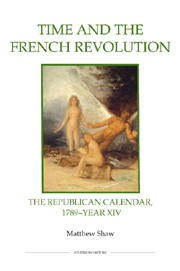Book contents
- Frontmatter
- Contents
- List of illustrations
- Preface
- Miscellaneous Frontmatter
- Acknowledgements
- Abbreviations
- Introduction: writing the history of the republican calendar
- 1 Time and history
- 2 The French republican calendar, 1793–1806: a narrative account
- 3 Cultivating the calendar: the calendar and republican culture in the Year II
- 4 The clash with religion
- 5 Work and rest
- 6 Republican hours
- Conclusion: the legacy of the republican calendar
- APPENDICES
- 1 Timeline of key events, 1788–1806
- 2 The republican calendar: a glossary
- 3 Names of the days of the republican year
- 4 Concordance for the Gregorian and republican calendars
- Bibliography
- Index
Conclusion: the legacy of the republican calendar
Published online by Cambridge University Press: 12 September 2012
- Frontmatter
- Contents
- List of illustrations
- Preface
- Miscellaneous Frontmatter
- Acknowledgements
- Abbreviations
- Introduction: writing the history of the republican calendar
- 1 Time and history
- 2 The French republican calendar, 1793–1806: a narrative account
- 3 Cultivating the calendar: the calendar and republican culture in the Year II
- 4 The clash with religion
- 5 Work and rest
- 6 Republican hours
- Conclusion: the legacy of the republican calendar
- APPENDICES
- 1 Timeline of key events, 1788–1806
- 2 The republican calendar: a glossary
- 3 Names of the days of the republican year
- 4 Concordance for the Gregorian and republican calendars
- Bibliography
- Index
Summary
This book has sought to uncover the history of revolutionary time not just in the pages of almanacs, diaries and official pronouncements, but in the ways that the years following the dramatic events of 1789 shaped the experience of everyday life. Accounts of the reshaping of everyday life have usually been stories of conflict or negotiation, often framed by intensely local contexts, but given political and ideological colouring. In contrast to the great journées of 1789, such as the storming of the Bastille or the abolition of feudalism, they may also appear at first glance to be matters of relative insignificance: the date of a meeting; the smudged pages of an almanac; the periodicity of the filing of official reports. Unlike the tearing up of the ancien régime on the night of 4 August and the days that followed, the reworking of everyday life leaves less obvious traces. None the less, the ordinary and the quotidian had their own inescapable importance and many of the Revolutionaries and their opponents understood the potential, and even the necessity, of planting the Revolution's flag on this terrain. It was in such details that the great claims for human progress of the Enlightenment and the Revolution could be mapped on an intimate scale and might make the leap between abstract schemes and the reality of a new, regenerated nation. The care that Romme took over the Annuaire du cultivateur, his patterning of the decade, month and year with the instruments, creatures and plants of agriculture and animal husbandry, suggests that he saw the cultivation of the land as the basis for a just and productive society.
- Type
- Chapter
- Information
- Time and the French RevolutionThe Republican Calendar, 1789-Year XIV, pp. 145 - 154Publisher: Boydell & BrewerPrint publication year: 2011

